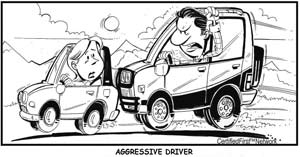
Be Aware of Aggressive Drivers
Brought to you by PPG - CertifiedFirst
Aggressive driving habits, such as tailgating, flashing headlights and unpredictable driving speeds can put motorists at risk for a collision.
“Aggressive drivers are not only a danger to themselves, they create hazards for other motorists and pedestrians,” says PPG's CertifiedFirst® Network. “The actions of aggressive drivers can divert the attention of other motorists from their own driving; raising the likelihood a collision could occur.”
 The National Highway Traffic Safety Administration defines aggressive driving as operating a motor vehicle in a way that endangers or is likely to endanger persons or property, including: speeding, running a red light or stop sign, failure to yield the right of way and reckless driving. Generally, aggressive driving stems from frustration and ranges from the annoying – flashing headlights, and honking – to the dangerous – tailgating, running red lights, weaving in and out of lanes, or speeding. The National Highway Traffic Safety Administration defines aggressive driving as operating a motor vehicle in a way that endangers or is likely to endanger persons or property, including: speeding, running a red light or stop sign, failure to yield the right of way and reckless driving. Generally, aggressive driving stems from frustration and ranges from the annoying – flashing headlights, and honking – to the dangerous – tailgating, running red lights, weaving in and out of lanes, or speeding.
Drivers between the ages of 18 and 25 have the highest aggressive driving tendency. Estimates are that one out of five accidents resulting in injury has a direct link to aggressive driving. (Sources: Monica Milla, “Aggression & Road Rage,” UNTRIResearch Review. Scott Bowles and Paul Overberg, "Aggressive Driving: a Road Well-Traveled," USA Today.
To avoid becoming an aggressive driver:
-
Be patient.
-
Don’t yell or gesture at other drivers.
-
Make safety a priority – don’t tailgate other drivers, and be sure to observe posted speed limits.
-
Budget enough time for your trip – beginning a drive with the stress of being late can limit your patience with other drivers.
-
Look for safe ways to relieve tension while driving – for example, find a type of music that is relaxing.
-
Avoid driving directly beside another vehicle for an extended time – be sure there is a traffic lane or berm open in case of an emergency.
-
Don’t take other drivers’ actions personally.
Avoid becoming the target of aggressive drivers by:
-
Using the left lane for passing only, this improves the orderly flow of traffic and can reduce driver irritation.
-
Resisting the urge to speed up or slow down when other drivers want to pass – maintain constant speed and let them by.
-
Using your turn signal BEFORE initiating turns or lane changes.
-
Being considerate – if the lane next to you is open, move over and allow other drivers room to merge onto the highway.
The CertifiedFirst® Network is a group of over 1900 independent and dealership-owned auto body repair shops that meet high standards of customer satisfaction and facility quality, verified by third-party evaluators. For more information on what to do in case of an accident or to learn more about the CertifiedFirstNetwork, visit www.certifiedfirst.com. |